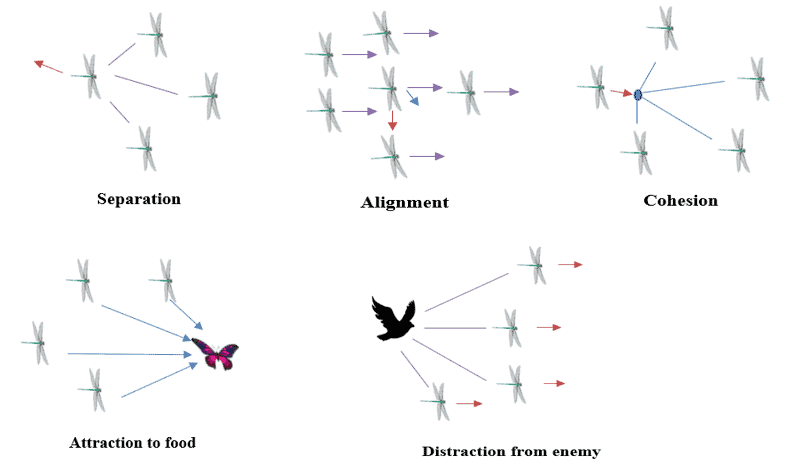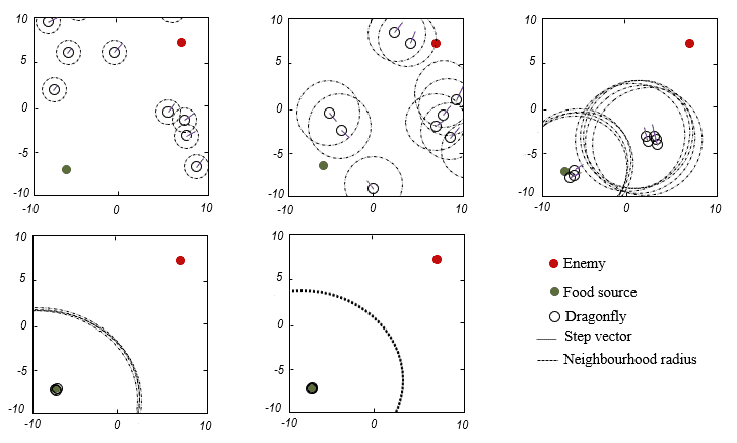1. 简介
蜻蜓算法(Dragonfly Algorithm)是一种相对较新的启发式优化技术,近年来在多个实际问题中展现出良好的优化能力。本文将介绍该算法的基本原理、数学模型及其伪代码实现,帮助读者快速理解其核心思想与实现方式。
2. 什么是蜻蜓算法?
蜻蜓算法由 Mirjalili 于 2016 年在格里菲斯大学提出,其灵感来源于自然界中蜻蜓的静态与动态集群行为。优化过程中的两个核心阶段——探索(Exploration)和开发(Exploitation)——正好对应了蜻蜓的这两种集群行为:
- 静态集群:蜻蜓形成多个小群体,分散在不同区域,类似探索阶段,帮助算法在搜索空间中广泛定位潜在解。
- 动态集群:蜻蜓形成一个大群体并朝着同一方向飞行,类似开发阶段,有助于算法快速收敛到全局最优解。
3. 蜻蜓算法的核心行为
蜻蜓的集群行为遵循以下三条基本规则:
✅ 分离(Separation):避免与邻近个体发生碰撞
✅ 对齐(Alignment):与邻近个体保持速度一致
✅ 聚集(Cohesion):向群体中心靠拢
在优化问题中,为了模拟生存需求,还需引入:
✅ 吸引(Attraction):朝向“食物源”(最优解)
✅ 排斥(Distraction):远离“天敌”(劣解)
这些行为共同决定了蜻蜓个体的位置更新机制,如下图所示:

4. 数学模型
蜻蜓算法的数学模型基于上述五种行为进行建模,每种行为都有对应的计算公式。
4.1 分离(Separation)
用于避免与邻近个体碰撞:
$$ S_i = -\sum_{j=1}^{N} (X - X_j) $$
其中:
- $ X $:当前个体的位置
- $ X_j $:第 $ j $ 个邻近个体的位置
- $ N $:邻近个体数量
4.2 对齐(Alignment)
使个体速度与邻近个体一致:
$$ A_i = \frac{\sum_{j=1}^{N} V_j}{N} $$
其中:
- $ V_j $:第 $ j $ 个邻近个体的速度
4.3 聚集(Cohesion)
使个体向群体中心靠拢:
$$ C_i = \frac{\sum_{j=1}^{N} X_j}{N} - X $$
4.4 吸引(Attraction)
引导个体向“食物源”靠近:
$$ F_i = X^+ - X $$
其中:
- $ X^+ $:食物源(当前最优解)的位置
4.5 排斥(Distraction)
使个体远离“天敌”:
$$ R_i = X^- - X $$
其中:
- $ X^- $:天敌(当前最差解)的位置
4.6 步长更新公式
蜻蜓的运动方向由以下公式决定:
$$ \Delta X_{t+1} = (s \cdot S_i + a \cdot A_i + c \cdot C_i + f \cdot F_i + r \cdot R_i) + w \cdot \Delta X_t $$
其中:
- $ s, a, c, f, r $:对应行为的权重系数
- $ w $:惯性权重
- $ t $:迭代次数
4.7 位置更新公式
蜻蜓的当前位置由步长更新而来:
$$ X_{t+1} = X_t + \Delta X_{t+1} $$
4.8 随机搜索机制
当没有邻近个体时,使用 Lévy 飞行进行随机搜索:
$$ X_{t+1} = X_t + X_t \cdot \text{levy}(d) $$
其中:
$$ \text{levy}(d) = 0.01 \cdot \frac{r_1 \cdot \sigma}{|r_2|^{1/\beta}} $$
参数说明:
- $ r_1, r_2 \in [0,1] $
- $ \beta $:常数
- $ \sigma $:计算公式如下:
$$ \sigma = \left( \frac{\beta! \cdot \sin(\frac{\pi \beta}{2})}{\left( \frac{\beta - 1}{2} \right)! \cdot \beta \cdot 2^{(\frac{\beta - 1}{2})}} \right)^{1/\beta} $$
5. 算法伪代码
以下是蜻蜓算法的基本实现步骤:
algorithm DragonflyAlgorithm():
// INPUT
// n = 蜻蜓数量
// OUTPUT
// 优化目标函数
初始化蜻蜓种群 X_i (i = 1, 2, ..., n)
初始化步长向量 ΔX_i (i = 1, 2, ..., n)
while 未满足终止条件:
计算每个蜻蜓的适应度
更新食物源和天敌
根据公式计算 S, A, C, F, R
if 邻居数量 ≥ 1:
更新步长向量 ΔX(公式6)
更新位置向量 X(公式7)
else:
使用 Lévy 飞行更新位置(公式8)
算法初始化时,随机生成蜻蜓的位置和步长。每轮迭代中根据邻近个体计算行为向量,并更新位置。若无邻近个体,则采用 Lévy 飞行进行全局探索。
6. 示例演示
下图展示了蜻蜓在搜索空间中动态调整行为的过程:

图中绿色圆圈表示“食物源”(最优解),红色圆圈表示“天敌”(最差解),黑色圆圈为蜻蜓个体,紫色线表示步长方向。参数设置如下:
- $ s=0.1 $, $ a=0.1 $, $ c=0.7 $, $ f=1 $, $ r=1 $
- 惯性权重 $ w $ 从 0.9 线性递减至 0.2
通过调整这些参数,可以控制蜻蜓在探索与开发之间的平衡,从而在不同阶段表现出不同的搜索行为。
7. 应用领域
蜻蜓算法已被广泛应用于多个领域,包括但不限于:
✅ 网络优化
✅ 机器学习参数调优
✅ 图像处理
✅ 无线通信资源调度
该算法因其较强的全局搜索能力和收敛性,成为解决复杂优化问题的一种有力工具。
⚠️ 总结提示:蜻蜓算法结合了生物启发式与数学建模,适合处理多峰、高维优化问题。但其参数敏感度较高,实际使用时建议结合问题特性进行调优。